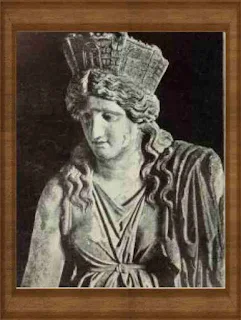The great mother of the gods
The introduction of the Sibylline Books during the reign of Lucius Tarquinius Superbus 1 is significant in the history of Rome as marking the point at which the native religion began to be arrested in its natural development and to be transformed under the influence of the religions of the East. It is true that the presence of the Greeks in Italy and the West, through a trade that was considerable, had had its effects on the Roman commonwealth even before this.
The Servian constitution bears the marks of the Greek system;
the system of weights and measures of the Romans had been brought into relation with that of the Sicilian Greeks; the Greek alphabet had been communicated through intercourse with Cumae 4; the statue of the Aventine Diana of the Latin confederation had been formed after the image of the Artemis of Ephesus at Massilia,
But the intercourse between the Romans and the Italian and Sicilian Greeks was purely commercial, and though its effects are not difficult to see in the less conservative departments of Roman life, in all that pertained to the inner and deeper life of the commonwealth Greek influence was still operating from a distance. Pliny refers to the making of the first statue of the gods to the time of Tarquini- us Priseus, and Varro says that none existed up to the time of Servius Tullius.
So far as the Roman worshiper from investing divinity with the human form and human attributes, as the Greek did, that for nearly two centuries the symbolism of flint for Jupiter, or a lance for Mars, 8 or fire for Vesta was the highest flight his imagination took, while the host of other deities — and they were as numerous as the acts and duties of the worshiper's life— remained entirely abstract and formless.
The acquisition of the Sibylline Books, then, occurred at a time when Rome had practically no acquaintance with the religions of the East; and the event may be regarded as the first pronounced step in the process which finally resulted in the denationalization of the old-Roman religion and the enthronement of a turba deorum whose worship was not in harmony with the genius of the early Romans, and which came to be in harmony with the genius of the later Romans only by reason of the change which that genius gradually underwent. The introduction of the Books is to be regarded primarily as a manifestation in the development of a new religious system; as a cause, it is to be regarded only in so far as it facilitated that development in a peculiar manner.
Contents:
Chapter I.— The Introduction of the Cult of the Great Mother at Rome 221
The Sibylline Books 221
Foreign cults at Rome 223
The Great Mother brought from Pessinus to Rome 225
Chapter II.— The Great Mother in the East. 230
In Asia Minor 230
Legends of the Great Mother and Attis 240
In Greece 249
Chapter III. — The Great Mother at Rome under the Republic 254
Progress of the cult 254
Its ministry 259
The Attis question 261
Causes of the growth of the cult 265
Chapter IV.— The Cult of the Great Mother under the Empire 269
Its rise to prominence 269
Its ministry 272
The annual festival 276
The taurobolium 280
Interpretation of legends 284
Attis as a symbol of the sun 287
Chapter V.— The Spread of the Cult under the Empire 291
In Asia Minor 291
In Greece 293
In other provinces 295
Causes of growth 298
Chapter VI— The Cult from the time of Claudius to its Fall 304
Period of prosperity, 304
Period of decline 306
Excavation of temple ruins 313
Chapter VII. — The Great Mother in Art, Literature, and Religion. 315
In art, 315
In literature 323
In religion 324
Download The great mother of the gods

